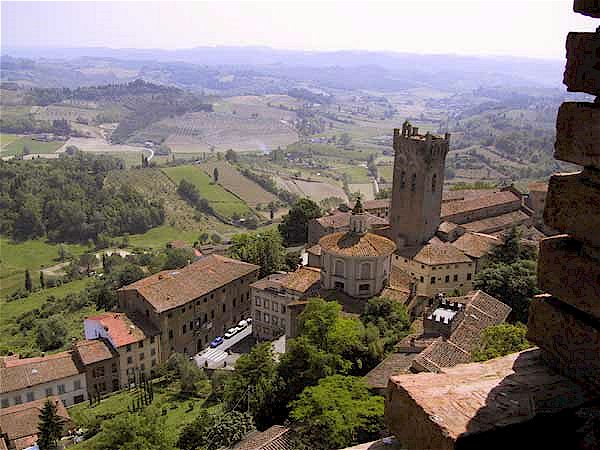

|
The Tourist Information Office of San Miniato is located in Piazza del Popolo and is open from Tuesday through Saturday from 9am to 5pm and Monday from 9am to 1pm. "San Miniato" is located in the lower Arno valley, on the south-eastern hills dominating the river plains, halfway between Pisa and Florence, in Tuscany, Italy. The mediaeval village of San Miniato is in the centre of Tuscany and it preserves an historic centre set on the hill top with the Cathedral, the Episcopal Palace, the Municipal Palace and the Tower Fortress dominating all the surrounding Arno, Era and Egola valleys. |
|
San Miniato was historically known as "San Miniato al Tedesco" to distinguish it from San Miniato al Monte, famous for its exquisite church and located just above the Piazzale Michelangelo in Florence, Italy. |
|
History of San MiniatoThe municipal territory of San Miniato, situated in the Lower Valdarno,
covers 102 sq km on the heights dominating the plain of the Arno between the
valley of the Egola and the
Val
d'Elsa.
In 1291, San Miniato was united to the Guelph league headed by Florence, fighting with them in 1307 against Arezzo and the exiled Ghibellines. San Miniato was the scene of the territorial battles and devastation for all of the XIV C. In 1313 alone, it lost various territories that rebelled against its dominion or were conquered by Pisa. These territories re-entered its possession in 1317 as a result of the peace treaty concluded within its walls between the Tuscan communities, even though the controversies continued until the treaty of Montopoli in 1329. In 1347, it was placed under the direct dominion of Florence against whom it rebelled in 1367 on the instigation of Pisa. After a long siege, it was reconquered in 1370 by the Florentines who substituted the Nickname “al Tedesco” with that of “Fiorentino”. San Miniato was elected Seat of the Vicarate of the Valdarno Inferiore and remained from then on under the authority of Florence.
In 1622, San Miniato obtained an Episcopal seat and title of City. A stay by
Napoleon in 1797 persuaded many to enroll in the "Revolutionary" army. After an uncertain participation in the movement of ’48,
San Miniato manifested support of Leopold II, soliciting at the same time the enactment of the constitution. Nevertheless, numerous
individuals from San Miniato participated in the war of independence in 1859. From 1929, San Miniato
developed a discreet, clandestine antifascist organisation and during the resistance formed a partisan brigade. Among its illustrious sons are Francesco I Sforza (1401-1466), the artist Ludovico Cardi called Il Cigoli (1559-1613),
the architect Antonio Piccolini (1772-1850) and the philosopher Augusto Conti (1822-1905). Things to see in San MiniatoThe Tower, on the summit of the hill at an altitude of 192 metres, dominates
the entire Valdarno. This tower was established in the 1200s but destroyed by the
bombs during the last war. It was reconstructed in 1958. It is called “di Federico” because Federico II had it built.
Click here to learn more about the truffles of San Miniato.
|
web site development and content management systems by ammonet
San Miniato © ammonet InfoTech 2005 - 2020. All rights reserved.